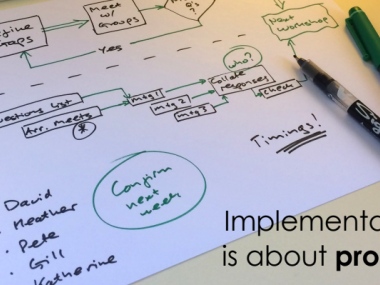TALKING ABOUT DOING: Finding a common language about implementation
Edited on
19 June 2019The URBACT Implementation Networks have supported cities to exchange expertise and knowledge about how to implement their projects more successfully, looking to understand and improve how the implementation of policy works in reality. Stay Tuned has been specifically focussed on projects to reduce Early Leaving from Education and Training (ELET), following and supporting nine cities on their implementation journeys to turn their strategies in to action at a local level.

But an early problem we found was defining what we meant by implementation in such a way that all the partners could engage in meaningful exchange on the topic? We went through a number of different approaches and iterations to help make sense of it and be clear. At the end of all this, we can reflect on what we think we mean by the concept of “implementation”.
What do we mean by “Implementation”?
The Implementation of any policy, strategy or project is crucial because it’s when things first leave the realm of the theoretical and come to life. It’s the act of turning our plans into reality.
Being successful in this regard is important because if we implement things badly, at best we change nothing on the ground; or at worst we create other problems and erode confidence in our ability to create positive changes.
In either case, there is no lasting change or no beneficial result. Worse, we may create the potential for negative results and reputational damage. This makes our future implementation attempts even more difficult.
One thing is clear: Implementation is a discipline in its own right. But what is that discipline about? In our situation of tackling urban and social challenges, we can begin to describe it by saying that implementation is about three things: Change, Process and Context.
about CHANGE
Creating something different. Transitioning from one state to another.
about PROCESS
Working through a sequence of actions and activities. Working in a structured and deliberate way.
about CONTEXT
Totally connected to the local situation in which we are working.
In improving our ability to implement policy and action plans well, we need to identify the main area for development – understanding where we are strong in our practice and where less so. Typically we have found that there are three aspects to look at for deliberately increasing: our capability, our focus and our resources. By improving in each of these areas, we increase our ability to implement successfully and to combine our knowledge of change, process and context to achieve the impact we are looking for.
Change can refer to changing structures, procedures, policies and regulations, setting up new projects or new systems. But Change can also be about changes to culture, behaviours, ideas, mindsets and ways of thinking. In our context of changing something in order to tackle complex urban challenges, changes to these “softer elements” are often needed first in order to enable the other (more structural and procedural elements) to be changed successfully.
Policy vs Implementation
Another important point to understand is that changing policy is NOT the same as changing reality. Just because a new policy is agreed doesn’t mean that it instantly has the real world effects the we are seeking.
Thomas Edison once said, “The value of an idea lies in the using of it.” Similarly, an action plan or policy achieves nothing if it is not implemented, and implemented effectively.
Changing Policy is NOT Changing Reality
Implementing Policy might Change Reality – if it’s done well.
This is the essence of the Implementation Networks – seeking to answer the question: HOW do we implement things well?
In Stay Tuned, one of the mainstays of our approach was to be as clear as possible about the separation of the WHAT and the HOW – making a distinction between the policy interventions we are designing (the WHAT) and the implementation of those interventions (the HOW).
So a key approach for the network has been to try to look separately at what to do to combat ELET; and then at how to do those things: how to make them work; how to do them well; how to ensure they have the impact we hoped for. This “how” is the essence of the exploration of implementation as a concept and as a practice.
Talking the same language
In applying our learning in practice, these two concepts (what and how) are not really separable. But to learn about implementation, to study the HOW and understand why things succeed (or not), we need to first consider the different parts in isolation. This approach, combined with some definition of what we meant by implementation has helped partners to develop a common language, terminology about implementation – to be clear what we are discussing and to put our focus onto the ‘how’ of implementation: assessing our proficiency in delivering projects and actions in an integrated and participatory way, identifying which skills and capabilities we have already and where our gaps lie. In turn, this meant building capability in the required areas in a more focussed way.
We saw that language is important: and even when we are speaking the same language, we don’t always understand each other! A common language is about shared understanding of the words we use and the way in which we use them. By establishing our common implementation language, we could work together better when exchanging and learning about the reality of implementation.
In the next post (Step By Step We Go), we look at the way in which we can learn about implementation more effectively.
Ian Graham
Lead Expert, Stay Tuned
Submitted by Matthias Peynshaert on
